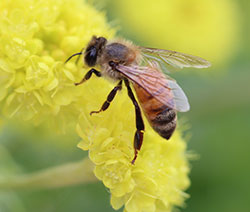By Andie Wommack, Douglas County Extension
 Often of people get houseplants as gifts or buy them to add
to their home décor. A couple weeks after they get it home, the plant starts to
deteriorate. The leaves start turning colors or, if it’s a blooming houseplant,
the blossoms start to die. This is not always cause for alarm. Getting the
plant from the store to your home can be stressful, and it could also simply be
that the leaves or blossoms have reached the end of their lifespan.
Often of people get houseplants as gifts or buy them to add
to their home décor. A couple weeks after they get it home, the plant starts to
deteriorate. The leaves start turning colors or, if it’s a blooming houseplant,
the blossoms start to die. This is not always cause for alarm. Getting the
plant from the store to your home can be stressful, and it could also simply be
that the leaves or blossoms have reached the end of their lifespan.
Overwatering is the number one killer of houseplants. The instinctive
reaction when we see a plant in distress is to water it. As it continues to
deteriorate we continue to water it unnecessarily. Too much water takes up all
of the pore space in the soil which causes the plants to suffocate. When it
comes to houseplants, more is generally not better. Your watering schedule will
depend on what kind of plant you have and things like the pot and media it is
in, how much sun it is getting, humidity, and temperature. Some plants do not
tolerate dry roots so they should be watered when the top layer of soil begins
to feel dry. Other plants prefer to dry out slightly between watering so feel
the soil below the top layer and water before the soil becomes completely dry
or the plant begins to wilt. Water your plants thoroughly, but do not allow
them to stand in water.
 Generally, homes in Colorado are much less humid than the
tropics where many houseplants come from. Providing extra humidity in your home
would benefit both your plants and your family. Our heating and cooling systems
circulate dry air, sometimes creating an environment with less than 10%
humidity. Misting plants can help increase humidity but can also cause foliar
diseases. Setting your plants on a humidity tray (a tray filled with gravel and
water) is a better solution as long as the bottom of the containers are not
sitting in water. Many cacti and succulents have adapted to dry conditions so
they are also great candidates for houseplants in Colorado. It is also
important to fertilize your
Generally, homes in Colorado are much less humid than the
tropics where many houseplants come from. Providing extra humidity in your home
would benefit both your plants and your family. Our heating and cooling systems
circulate dry air, sometimes creating an environment with less than 10%
humidity. Misting plants can help increase humidity but can also cause foliar
diseases. Setting your plants on a humidity tray (a tray filled with gravel and
water) is a better solution as long as the bottom of the containers are not
sitting in water. Many cacti and succulents have adapted to dry conditions so
they are also great candidates for houseplants in Colorado. It is also
important to fertilize your  Another reason your houseplant may be struggling is that it
needs to be repotted. If you pull your plant out of its pot and there is more
than a 50-50 ratio of roots to soil, it needs to be repotted. If there is more
than 50% roots in the pot, your plant will dry out quicker which can make it
hard to keep up with watering. When choosing a pot for your houseplant it is
really important that it had drainage holes. Many decorative pots don’t have
drainage holes so you may want to double pot them by having your plant in a
plain pot placed inside of a decorative one. Choose a pot that is 1-2” larger
than the root ball of your plant. Always use fresh potting mix when you are
repotting your plants and bleach pots if you have used them before. Some plants
like orchids and cacti need specialized potting
Another reason your houseplant may be struggling is that it
needs to be repotted. If you pull your plant out of its pot and there is more
than a 50-50 ratio of roots to soil, it needs to be repotted. If there is more
than 50% roots in the pot, your plant will dry out quicker which can make it
hard to keep up with watering. When choosing a pot for your houseplant it is
really important that it had drainage holes. Many decorative pots don’t have
drainage holes so you may want to double pot them by having your plant in a
plain pot placed inside of a decorative one. Choose a pot that is 1-2” larger
than the root ball of your plant. Always use fresh potting mix when you are
repotting your plants and bleach pots if you have used them before. Some plants
like orchids and cacti need specialized potting
Your houseplant may have a disease or insect problem. Look
for visible signs of insects on your plants if you notice them deteriorating. You
can see many houseplant insects with your naked eye. If you think you may have
an insect problem, reach out to your local Extension office or nursery for help
diagnosing your plant and coming up with a treatment plan.
CSU Extension has a wide variety of resources on houseplants
and their care. If you cannot find the information you need or have further
questions, please reach out to your local Extension office!


















